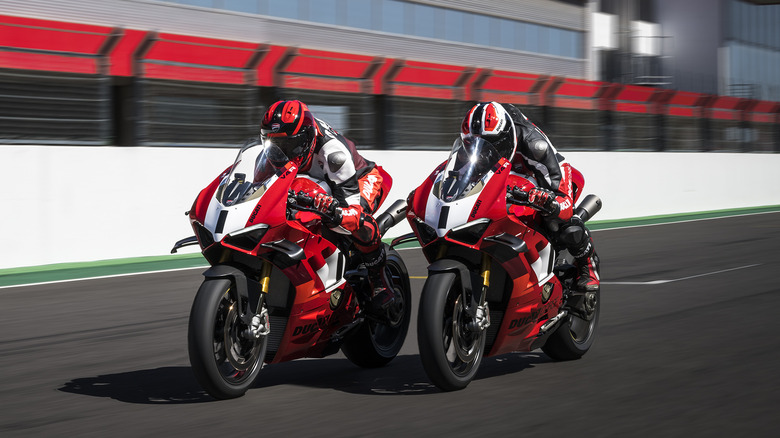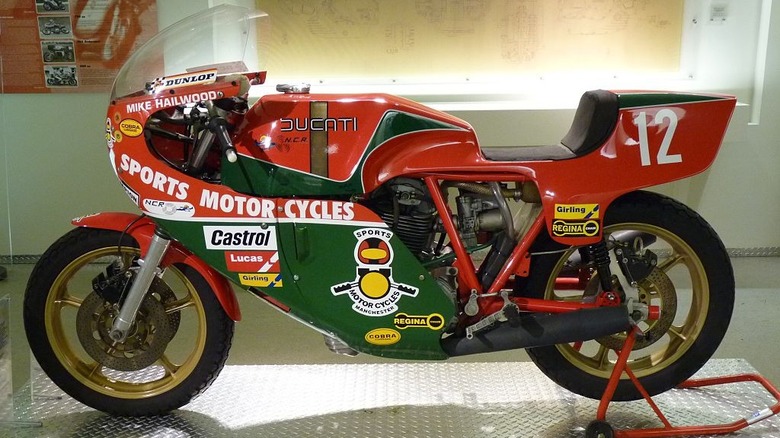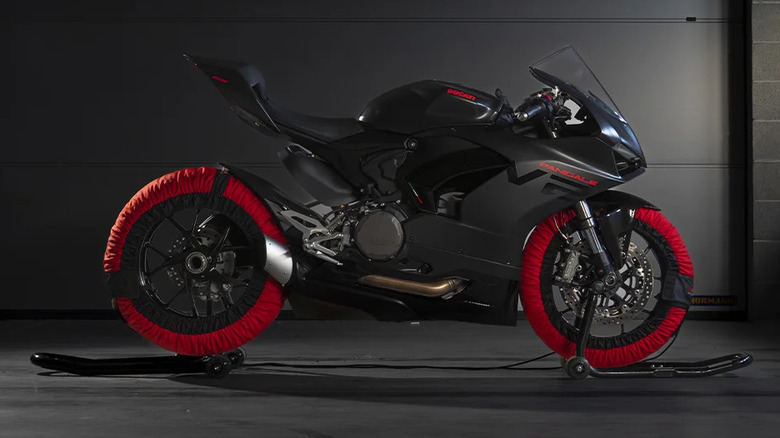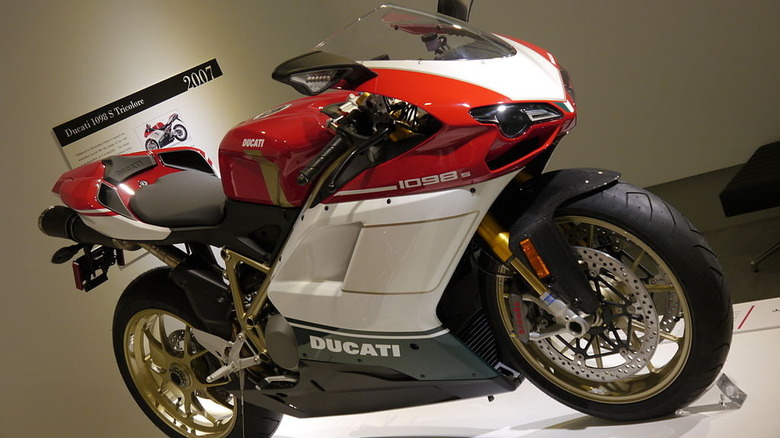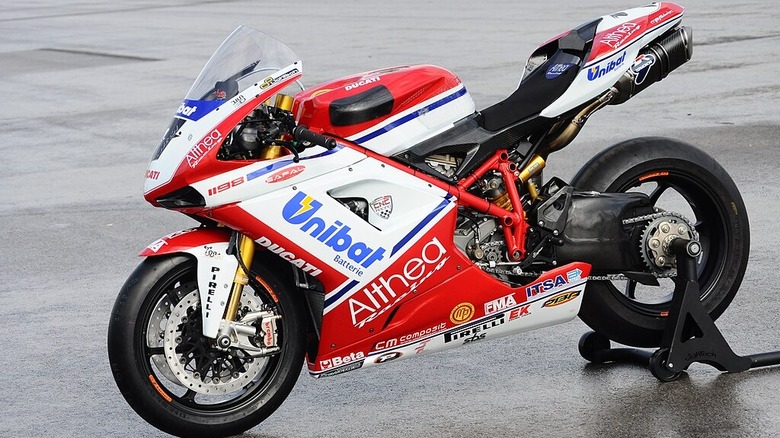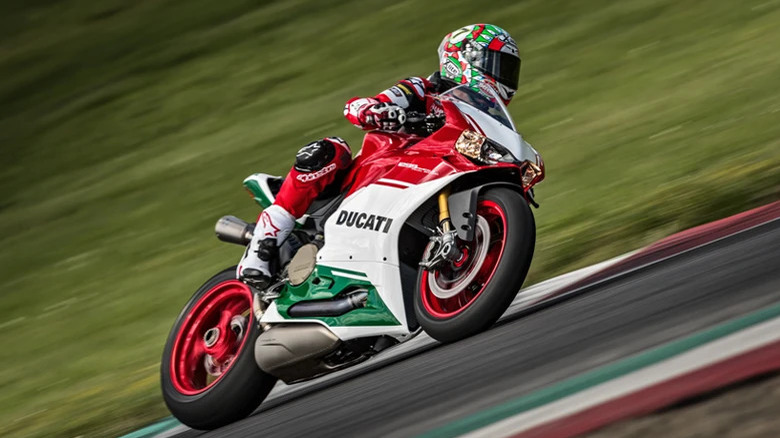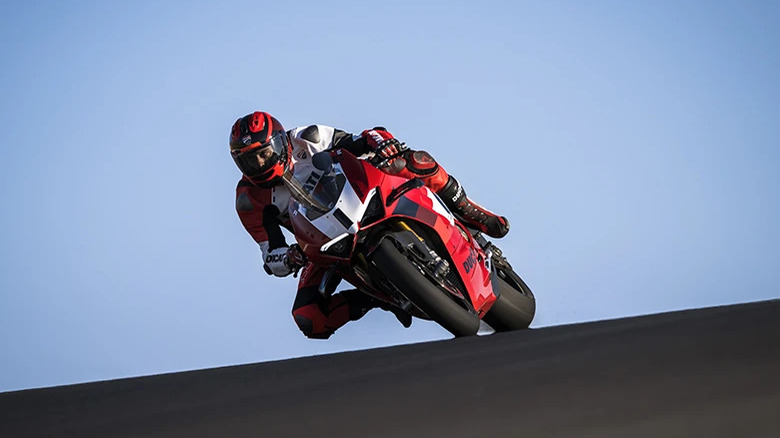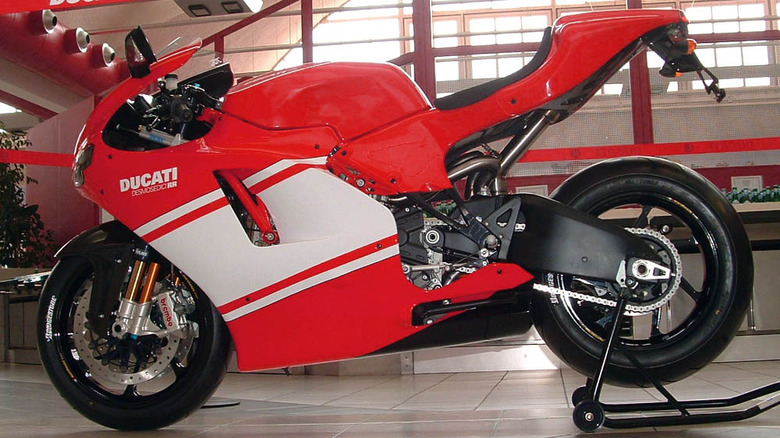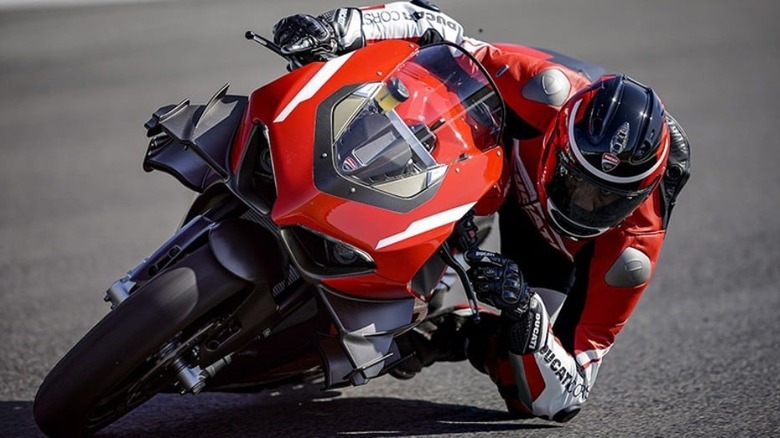8 Of The Fastest Ducati Motorcycles Ever Built, Ranked By Top Speed
Revered Italian marque Ducati has produced some of the most aspirational motorcycles ever built over the course of its almost 100-year history. Often likened to its compatriot sportscar manufacturer, Ferrari, it is known for its typically red livery and prominence in competitive motorsports. Its machines are also notable for their exceptional build quality, premium price tags and, of course, their speed.
The Bologna-based brand is renowned for developing some impressively fast production motorcycles. These gained prominence with the adoption of a desmodromic valve system in the mid-20th century, a mechanical development that eliminated valve springs, allowing for more precise valve control, resulting in more powerful engines. An innovative approach to motorcycle production has continued during the intervening years; Ducati remains among the most pioneering manufacturers in its field.
Ducati has long been a major contender in MotoGP, with over 80 victories, and the World Superbike Championship, with over 400 wins. Off the track, it continues to impress with its extensive catalog of high-performance roadgoing machines that cover a variety of segments, from fully-fared racing models to naked bikes, supermotards, cruisers, and adventure bikes.
Here are the fastest Ducati models, ranked by top speed, as verified by independent sources, including Fastest Laps, Motorcycle Specs, and Ducati itself, where possible. Manufacturer data is rarely available for top speeds outside of videos produced during testing, so we have compiled information from the most consistent references here. It's worth noting that since the turn of this century, an agreement between significant motorcycle brands capped their production motorcycles' top speeds at 186 mph. Hence, only limited-edition or race replica models exceed this speed at the top of this ranking.
1975 Ducati 900SS -- 135 mph
A top speed of 135 miles per hour and a standing quarter-mile of 12.6 seconds sounds pedestrian by today's standards, as many mid-capacity modern bikes can attain speeds that top this. However, in 1975, it ranked the Ducati 900SS as the fastest production motorcycle of its day, a distinction it held for one year before the Laverda Jota succeeded it.
The "SS" moniker stood for Super Sport, a fitting title for a bike that had its roots in competition racing at the 1972 Imola 200. Ducati wished to produce a street-legal road racer based on its race-winning 750 Super Sport model that would be capable of leaving everything else for dust. It bumped up its engine capacity to 860cc and stripped it down to the bare essentials required for high performance. With its half-faring, clip-on handlebars, and racing seat, it looked poised for the track and performed accordingly, with plenty of raw power and agility.
The Ducati 900SS was a trailblazing race replica model that was among the first to usher in a new wave of fully-fared racing bikes that were attainable for the everyday rider. The next decade heralded some impressively fast liter-class bikes, especially from the "big four" Japanese manufacturers, including the Honda VF1000R, Kawasaki GPZ900R, Suzuki GSX-R, and the Yamaha FZR1000, each successively quicker than the last. Yet it was the Italian Ducati that helped initiate the change that paved the way for the roadgoing sport bikes that are so ubiquitous today.
2020 Ducati Panigale V2 -- 168 mph
Fast forward to the new millennium, and Ducati has cemented itself as a global leader among sport bike manufacturers and race teams. Two decades in, the marque further secured its standing with the introduction of the 168-mile-per-hour Ducati Panigale V2. This fully-faired machine shares several common attributes with modern Ducati sport bikes, including its single-sided swingarm, large air intakes, and advanced aerodynamics.
The Panigale V2 may not be as quick as many of its brand contemporaries, but it is no less refined. It features cutting-edge electronics and a finely tuned Superquadro twin-cylinder power plant that is more compact than the 210-horsepower Desmodedici Stradale engine, later used in the Panigale V4R. The 955cc Panigale V2, by comparison, produces 153 brake horsepower but is lighter, nimbler, and corners better than its bulkier siblings.
Straight-line acceleration aside, the Panigale V2 shouldn't struggle to keep up when pitted against many more powerful machines on a racetrack. Braking is also optimized for track performance, with several ABS modes and an anti-rear-wheel-lift feature to ensure the bike stays firmly planted when approaching a corner, further improving lap times. While a 168-mile-per-hour top speed is impressive in its own right, this surprisingly quick bike offers superior performance and handling.
2007 Ducati 1098 -- 171 mph
Every now and then, a motorcycle comes along that is described as a game-changer. As an innovative brand, Ducati has produced a few of these, namely its 916 sport bike, Monster 900 naked bike, Hypermotard supermotard model, and the Ducati 1098, which was released in 2007 to a rapturous reception.
With its roots in the Ducati 916, which Motorcycle News described as the most beautiful bike in the last 50 years, the 1098 adopted many of its most appealing features. These included the clean, fully-faired aerodynamics, twin under-seat exhausts, single-sided swingarm and, perhaps most importantly, a wholly enjoyable, immersive rider experience. This was further embellished by the quality of its 1,099cc Testastretta Evoluzione engine, which was Ducati's most potent V-twin to date, delivering a whopping 160 brake horsepower and pushing the bike to a top speed of 171 miles per hour.
The 1098 was further improved for the racetrack and released in a limited-edition homologation special as the 1098R, but the original stock model was more than enough to satisfy even the most throttle-happy rider. Combine this performance with excellent reliability and high-spec features for the time, and the 1098 left little to be desired. Yet, it enjoyed a short-lived run, as it was taken out of production just two short years after its release and replaced by the larger-capacity Ducati 1198.
2011 Ducati 1198SP -- 175 mph
Around 2010, Ducati seemed anxious to push its product line to the limits. Having already produced the excellent 1098, there was no resting on its laurels after releasing its successor, the 1198. This was described as having one of the best V-twin engines ever made by the biking authority Motorcycle News and was widely considered an advancement over its predecessor. Yet the Ducati development team in Bologna still felt there was room for improvement, and the result of their unending quest for perfection was the 1198SP.
The "SP" iteration of the 1198 marked several improvements on the earlier production model. These included a slipper clutch, a quickshifter, a more advanced suspension, and a larger fuel tank while still managing to shed a kilogram in weight. These embellishments combined to provide a more satisfactory riding experience that was more in line with that of a competition-level machine. However, the 1,198cc eight-valve desmodromic engine remained unchanged, as this unit was impressive enough, with its 170 brake horsepower output that delivered a top speed of 175 miles per hour.
By 2011, Ducati had ironed out the creases with previous models' reliability issues while making continual improvements in performance. However, it found itself up against some stiff competition in the liter-class segment, with models including the BMW S1000RR and Aprilia RSV4 often providing higher specs and more advanced features in comparison. The 1198 would be succeeded by the 1199 Panigale, which marked a new generation in the high-performance Ducati sport bike lineage.
2017 Ducati 1299 Panigale R Final Edition -- 186 mph
If the Ducati 1299 Panigale R Final Edition sounds like a mouthful, that is because it is highly advanced when compared to the base model Ducati 1299 Panigale. The distinction is certainly apparent when considering it costs almost double that of its sibling, at a shade under $40,000, but it soon becomes clear that the Final Edition marks a definitive step on the evolutionary ladder.
As the name suggests, the Final Edition represents the last in the line of the 1299 Panigale series. It is a fitting tribute, with its 1285cc, 209-brake-horsepower V-twin power plant, and premium accessories. These include fully adjustable Ohlins shocks at the front and rear, a high-spec Akrapovic exhaust, and Brembo brakes providing pinpoint stopping power. At the time of its release, the Ducati 1299 Panigale R Final Edition had the highest power-to-weight ratio of any of its contemporary production models, weighing in at just 168 kilograms, although it features an aluminum monocoque chassis, as compared to the ultralight carbon fiber frames used on Ducati's Superleggera models.
It's little wonder that several years after its release, the Ducati 1299 Panigale R Final Edition is still in production and no less impressive when pitted against more up-to-date machines. It still feels fresh and modern, thanks to a full complement of electronic rider aids, including multiple riding modes, cornering ABS, and traction and engine braking control. And while its hefty price tag may be prohibitive for many, it is still one of the most admired — and fastest — Ducatis in production, with a top speed of 186 miles per hour.
2023 Ducati Panigale V4R -- 186 mph
The Panigale range of sport bikes was named after a small town on the outskirts of Bologna, Italy, known for its automotive manufacturing prowess. They are characterized by their monocoque frames which, like Formula One cars, use the engine as a stressed member that strengthens the chassis. This allows for robust and lightweight construction, and a motorcycle capable of dealing with the demands of competitions such as the World Superbike championship, which is precisely what the Ducati Panigale V4R was built for.
As a road-ready sport bike, it could be said that the Panigale V4R is over-qualified for regular riding. It is Ducati's most powerful production bike to date, with 231 brake horsepower wrung from its 998cc power plant when equipped with an upgraded exhaust. Like the 1299 Panigale R Final Edition, its top speed is artificially limited to 186 miles per hour, but top speeds have been speculated to be well over 200 miles per hour when unrestricted. The bike was further optimized for speed in 2023 with revised aerodynamics, including redesigned wings that create less drag and a carbon-fiber mudguard, and it was given a larger fuel tank.
Somewhat expectedly, a racing thoroughbred with these kinds of specs is priced accordingly, at around $45,000. For this, you are treated to premium parts throughout and plenty of track-friendly features, including an electronic suspension, advanced traction control and slide control systems, and dual lap timers. Yet all this is irrelevant if you don't possess the requisite skills to put the Panigale V4R through its paces, and this is a privilege that must be earned.
2007 Ducati Desmosedici RR -- 188 mph
The Ducati Desmosedici RR feels like an outlier in the Ducati lineage. When the 1098 model was still on the drawing board, it produced a race replica of the Desmosedici GP6 bike that Ducati entered for the 2006 MotoGP championship. This was little more than a competition-level motorcycle with additional lighting to make it street-ready, and the closest many would ever get to experiencing the real thing.
As an exclusive, limited-edition model, the Desmosedici RR was allowed to break the constraints of the capped 186-mile-per-hour speed limit as agreed upon by the top superbike manufacturers. Most accounts place it at around the 188-mph mark for those with the nerve to push the bike to its limits, and with a 0-60 acceleration time of under three seconds, it is among the quickest roadgoing bikes ever created.
A MotoGP bike is different from a regular superbike in many ways. They are considerably lighter and more powerful, with the Desmosedici RR's dry weight at 171 kilograms and 200 brake horsepower at your fingertips. They are also built very differently, with a race-tuned engine and stiffer chassis to facilitate more aggressive riding. These features are wasted on the average rider without the capabilities to get the most out of the machine. Yet, the Desmosedici RR remains one of the most desirable Ducatis of all.
2020 Ducati Superleggera V4 -- 190 mph
The Ducati Superleggera V4 is the most exclusive motorcycle Ducati has ever made, with a limited production run of just 500 units. As we discussed in an earlier article, this is the Holy Grail of Ducati ownership, as reflected by its $100,000 price tag. It is considered the pinnacle of the high-performance marque's 100 years of research and development, and it beats all its previous production motorcycles in terms of its power-to-weight ratio — 1.54 horsepower per kilogram — and its top speed.
While the official top speed of the Ducati Superleggera V4 seems to be a closely guarded secret, with no official records according to our research, Ducati released its own video of the bike in testing. Here, Ducati's official test rider, Alessandro Valia, is seen to clock 190 miles per hour at a circuit in Portimao, Portugal. In his own words: "All you can feel is the pure emotion of speed."
To achieve its remarkable top speed, the Superleggera V4 combines a carbon fiber swing arm, wheel rims, and chassis (with aluminum forks), and a titanium rear spring and fixtures as weight-saving measures. Superleggera means "super light," and the bike lives up to the name, tipping the scales at 159 kilograms. It has two carbon fiber wings on each side, producing the 50 kilograms of downforce necessary to keep the bike connected to the road at speed, and traction and braking are unsurprisingly of the highest level.
The Superleggera V4 helps explain the raw appeal of Ducati motorcycles when pushed to their limits. They offer an immersive and emotive experience resulting from their considerable racing heritage. Ducati seemingly asks itself whether it can while ignoring whether it should, and the outcome is some of the fastest motorcycles ever made.
